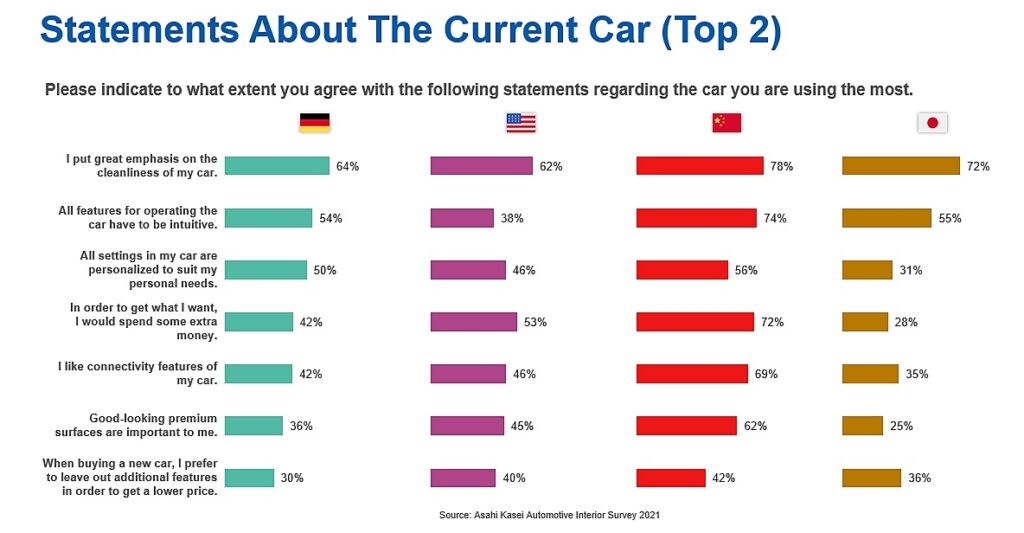In November 2021, Japanese multinational Asahi Kasei conducted its third Automotive Interior Survey in conjunction with Cologne, Germany-based market research institute Skopos. The survey covered four major automotive markets, the USA, Germany, China and Japan. It quizzed 1,000 car users of varying income levels in each market, who responded to questions regarding their car purchasing behavior, understanding of automotive sustainability and preferences regarding automotive interiors.
The survey found that while fuel and power consumption, drivetrain technology, running costs and driving performance remain dominating purchasing decision factors, interior design has continued to grow in importance. According to the report, half of all users in the four main markets would take interior design into account when making their next car purchase.
Of particular note were findings related to vehicle owners’ opinions about the perceived cleanliness of vehicle interiors, and the way these opinions varied from region to region. While car users in China were clearly annoyed by “unpleasant odors” (48%) and the so-called “new car smell” (23%), the share of car users annoyed by these factors was significantly lower in the other regions.
Bn contrast, “scratches on visible surfaces” bother 25% of users in Germany, an increase from 21% in 2020 and the same attitude was observed in the USA, with 29% of car users being annoyed by scratches (2020: 19%). “Stains on fabrics” were noted as an annoyance factor for 30% of car users in Germany (2020: 26%) and 32% in the USA (2020: 26%).
Following the theme of cleanliness, a majority in all regions saw a benefit to the use of “water and dirt repellent surfaces,” with 74% in China, 70% in the USA, 65% in Japan and 63% in Germany. “Surface and seating materials that are easy to wash” was also held in high regard, especially in the USA (81%) and in China (80%).
Heiko Rother (top), general manager, business development, automotive, Asahi Kasei Europe, said, “Cleanliness was highly valued by car users even before the pandemic. The last two years have further fueled this desire, and the definition of ‘cleanliness’ has broadened.”
Mike Franchy, director of North American Mobility at Asahi Kasei America, commented, “With the cost of vehicles increasing consumers have their vehicles longer and want surfaces that are highly durable, easy to clean and continue to look new over time. In addition, our Healthy Car portfolio of anti-microbial textiles and plastics, along with technology to ensure interior air quality, we have solutions for the OEMs to address these needs of the market.”
The findings of the survey also showed that sustainability is no longer only defined by a vehicle’s drivetrain technology, but also by the choice of materials. For example, roughly half of the car users in Germany, China and the USA characterized a sustainable car as being one based on materials made from highly recyclables. However, car users in Japan prioritized hybrid drivetrains over recyclables when characterizing sustainable automobiles.
This growing awareness of sustainability in automobiles was also reflected in the car users’ willingness to spend more money on a sustainable vehicle. In China, two out of three car users would pay more, in the USA and Japan a third, and in Germany a fourth.
Rother said, “The definition and the perception of sustainability in automobiles is changing. Car users are looking more into the materials being used – electrification alone is not enough anymore. More sustainable interior surface materials that are also good-looking, durable, easy-to-maintain and clean will get more attention from car users. In the end, a ‘long-lasting’ material quality is being recognized as more sustainable.”



